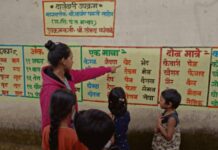Dear Reader,
In yesterday’s newsletter, we laid out the context behind some of the new National Education Policy’s (NEP) biggest and boldest moves in India’s schooling sector. Today, we’re tackling the less talked about higher education institutions (HEIs).
Before we start though, here is the stat that best encapsulates the sector: our gross enrolment ratio (GER) for higher education was 26.3% in 2018-19. This figure expresses the number of students actually enrolled in HEIs (3.74 crore), as a percentage of the total eligible HEI student population. Or, simply put, only 26.3% of India’s potential students are enrolling in the country’s 945 recognised universities.
Now, the NEP seeks to raise the GER to 50% by 2035. Yet, that’s a big ask, because big reforms are required to make HEI more accessible and easy to enter across the board. Half the challenge is improving the quality of school education, so that less students drop out, and more students enter the higher education ecosystem (click here to read our explainer on the NEP’s reforms.) The other half is executing internal reforms within the sector itself, where currently enrolled students have been facing the brunt of a poorly supported and financed learning ecosystem. The question is: does the NEP effectively address the second set of reforms?
Reform 1: While history textbooks are pilfered with on an annual basis, in general, India’s school and university curricula have traditionally been viewed as rigid, if not stagnant. That’s possibly why the NEP is focusing on “ending the fragmentation of higher education” and transforming all HEIs into “large, multidisciplinary universities” by 2040. It also seeks to set up a National Research Foundation to “grow and catalyze research across the nation.” Undergraduate (UG) programs are now to be 4 years long instead of 3 (with multiple exit options), while a five year integrated bachelor’s and master’s is also on the cards, to provide a direct pathway to PhD programs.
These are good steps, and could definitely help revive interdisciplinary research and reverse India’s ‘brain drain’ as Harsh Ghildiyal and Sourya Reddy note. However, according to Tanvi Mehta, the affordability of a four year ‘liberalised’ UG, first proposed in a draft NEP in 2019, for lower income students is suspect. Furthermore, with the funding for ‘Arts’ on a downward spiral, and the MPhil unceremoniously discontinued in the NEP, is a vision of interdisciplinary education enough to address the realities of a lack of institutional support for certain types of research in India?
- Plugging the Brain Drain: Revitalising Research in India, by Harsh Ghildiyal and Sourya Reddy
- The Paradox of Liberalising our Universities, by Tanvi Mehta
- Money for Nothing: The Disconcerting Future of the Humanities in India, by Ishani Pant and Kirti Dass
Reform 2: the NEP seeks to reorient learning away from exams and towards, well, learning, provide faculty with more incentives to teach and research better, improve the inclusion of oppressed groups and genders, and make India an international destination “for premium education at affordable costs.” These are great ideals to aspire towards, and address serious structural issues within the higher education ecosystem. However, once these goals have been outlined, the main question arises: how will all these changes be funded in the long run?
By the institutions themselves, as the NEP clearly desires that HEIs become more autonomous–from the state–in terms of their financial operations. Now, for an institution to run on its own, students will have to pay more fees, which curbs the ability of HEIs to provide subsidised education. HEIs may also be more indebted to toeing the government line in order to secure grants or loans from the newly formed overarching higher education regulator, the Higher Education Commission of India (HECI), which is set to replace the University Grants Commission.
And so, the notion of higher education as a public good as a result of the NEP’s objectives could be seriously challenged, as Aarushi Aggarwal noted back in 2018, when the proposal for the HECI was first announced. Fee hikes also raise more financial barriers to higher education, as Mutahhar Amin and Shyam Krishnakumar noted last year, when the JNU protests over fee hikes first erupted. During a pandemic-induced recession, which could last for years, this could only force more drop outs. Autonomy paves way for some amount of privatisation in higher education–which may be antithetical to the state’s dreams of a GER of 50% by 2035.
- In Pursuit of Autonomy: Does the HECI Fit the Bill? by Aarushi Aggarwal and Kirti Dass
- Of Privilege and Priorities: JNU Protests from the Frontline, by Mutahhar Amin and Shyam Krishnakumar
- How Much is Too Much? University Fees Amidst COVID-19, by Akshobhya Reddy and Sanjana Sundar
Reform 3: the larger spirit of this 70 page document that we’ve been pouring over since Wednesday, is to create an educational system that inspires and supports students’ independent critical thinking. All of this is being done for the interest of the student’s growth and development. Again, an admirable sentiment.
Yet, it remains to be seen if the state–at least under the NDA of late–really does support critically thinking students and HEIs. Its actions against protesting students in Delhi, or ignorance of the plight of Kashmiri students facing an Internet shutdown are a case in point. All of this points towards a paternal ecosystem, the new normal if you will, that seems to swat away legitimate critical thought as opposed to engaging with it constructively. If school is where knowledge is first learnt, university is where it is freely applied by adults–will the Centre’s heavy handedness slant the potential outcomes of the NEP?
- No Country for Student Dissent? by Sourya Reddy
- Learning Under Lockdown: Voices From Kashmir, by Evita Rodrigues
That’s it for the main coverage, yet, there’s so much more we wish could have covered in depth in these two epistles. Here are some points of interest within the NEP that missed our highlight reel, but are still of great importance:
- The policy, according to The Indian Express, was produced in close consultation with the Sangh. The Sangh’s requests, amongst others, included celebrating India’s history, and placing more prominence on Sanskrit and other ‘classical’ languages–these specific ones were included in the policy. Shreyasi Rao’s deep dive from 2019 explores this debate on the place of the ‘classics’ within our classrooms. Kaushalya and Avantika further explore how ‘secular’ education is experienced by minority communities.
- You’d think that a national education policy released during a pandemic would actually talk about managing education during said pandemic. Think again. COVID-19 has produced pressing challenges that require tailored solutions and support. Our flagship series Education in Times of COVID takes a look at the realities of India’s education sector right now–from ed-tech struggles to mental health–and what we can do to fix them in the long run.
That brings us to the end of this week’s newsletter. If you’ve caught the education bug from the news of the NEP, you may enjoy reading more of our education coverage here. If you’d like to contribute to our growing education reportage, please click here to read our submission guidelines, and then drop your pitch off at [email protected].
Many of the changes we see in the NEP today were first announced years ago, and carefully reported on by The Bastion back then. If you enjoy our work, please do consider supporting it. Every rupee helps us continue producing critical, independent, and ahead of the curve journalism on the future of education in India.
Stay safe, and happy reading this weekend!
Aarathi Ganesan
Editor, The Bastion






